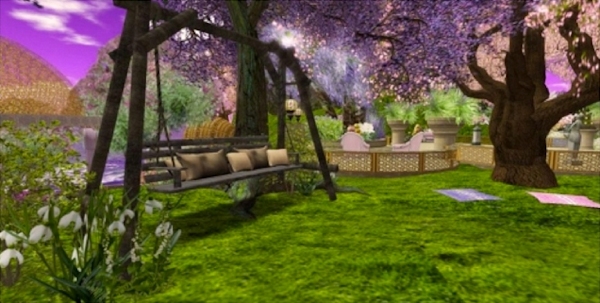[From U-T San Diego (the San Diego Union-Tribune); for more information, including the significance of the image, see “Second Life’s Second Life for Social Innovation” in the Stanford Social Innovation Review]
PARKINSON’S PATIENT, 86, BUILDS A NEW LIFE IN VIRTUAL WORLD
Parkinson’s patients shed their limitations in simulated online universe
By Pam Kragen Sept. 24, 2013
CARLSBAD – When Fran Swenson visits Creations Park each day, she takes tai chi classes, swims, ice skates and goes ballroom dancing.
Although Parkinson’s disease and macular degeneration have reduced the 86-year-old La Costa resident’s ability to walk, see and leave her one-bedroom apartment, she has no such limitations in the lushly landscaped Creations Park — a “sim” or virtual-reality world — in the online universe known as Second Life.
Shortened from Creations for Parkinson’s, the sim is an online community where people with Parkinson’s can interact through digital avatars to share stories, exercise, shop and enjoy an active life that is no longer possible with their physical bodies. Through her avatar “Fran Seranade,” Swenson said she has found a great hobby, friends, a support group and relief from some symptoms.
“It’s a place that gives me great satisfaction,” said Swenson, who lost her husband to Parkinson’s in 2003 and was diagnosed with the same disease a year later.
Swenson said her physical limitations are less frustrating to her now with the fantasy world of Second Life. “I’m dancing now and I can run, hop, jump and have fun. I’m not just in my apartment, I have the whole world now. It’s thrilling.”
Second Life has about 1 million subscribers worldwide, most of them in Europe, with an average of 60,000 active users daily. There are hundreds of Second Life support groups for people with disabilities, most of them accessible through Virtual Ability (virtualability.org), a user-friendly gateway “island” where people with disabilities can find others facing similar challenges.
Tom Boellstorff, an anthropology professor at UC Irvine who wrote the 2008 book “Coming of Age in Second Life,” said virtual reality worlds are a great social and emotional outlet for disabled people who can no longer drive, leave their homes or perform their old jobs.
“Almost all disabilities in Second Life are invisible,” said Boellstorff, who holds a Ph.D. in anthropology from Stanford University. “That’s liberating for some people, because they’re not being judged for the first time in many years.”
Creations Park was developed 2½ years ago by Swenson’s daughter, Barbara Richards of Carlsbad. Four years ago, Richards and her brother, who lives in Florida, created a family sim island in Second Life where they could interact with their mother online. After seeing the joy it brought her mom, Richards built Creations Park, a much larger sim for Swenson and other people with Parkinson’s where they could form a weekly support group and raise money for Team Fox, a grass roots fundraising division of the Michael J. Fox Foundation for Parkinson’s Research.
Last year, Creations visitors raised $4,000 for Team Fox. This year’s goal is $12,000.
Richards said one of the biggest challenges is finding enough people with Parkinson’s to visit Creations Park (the Thursday group sessions average six to 15 people).
Among the reasons are the negative stigma associated with Second Life because many people use the site for sexual fantasy role-playing. In addition, many first-timers get frustrated with the steep learning curve associated with virtual reality, and some Second Life people with Parkinson’s say they don’t want to talk about their disability online because it’s the one place they can escape it.
Cost is also a factor for some. Joining Second Life is free, but there is a cost to purchase clothing, housing and other goods. Richards said a user could spend as little as $10 to $20 a month, but her family spends more than $5,000 a year to maintain both of its very large sims. Swenson said it’s worth every penny.
“I feel so close to the people there with Parkinson’s disease because we know what we’re experiencing and other people don’t,” Swenson said.
Swenson said she has also experienced some improvements in her physical mobility as a result of Second Life. Two weeks after starting her avatar in tai chi classes, Swenson said she began walking better and now she can stand up from her chair without needing a motorized lift.
Boellstorff at UC Irvine said Swenson’s belief that she has improved physically through her avatar — which he calls “the Fran Effect” — may be triggered by mirror neurons, where neurons in the brain trigger the mind into imagining it is performing the same action the eyes see someone else doing. He has been investigating Swenson’s experience with Donna Davis, a strategic communications professor at the University of Oregon, who wrote her dissertation on relationships in Second Life.
Davis was so intrigued by the “Fran Effect,” she built an adjoining island to Creations Park called Frantastica where she now hosts the weekly Parkinson’s support group sessions, in hopes of learning more about how the avatars can help patients.
“When I first got Parkinson’s nine years ago, I wondered ‘why me?’?” Swenson said. “But now I believe there’s a reason why it happened — so I could reach out to others with Parkinson’s and offer them some form of relief. Now I tell people I have Parkinson’s, Parkinson’s doesn’t have me.”
